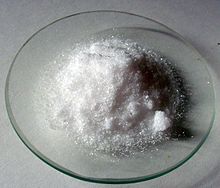Sodium molybdate

| |

| |
| Names | |
|---|---|
| IUPAC name
Sodium molybdate
| |
| Other names
Disodium molybdate
| |
| Identifiers | |
| |
3D model (
JSmol ) |
|
| ChEBI | |
| ChemSpider | |
ECHA InfoCard
|
100.028.683 |
| EC Number |
|
PubChem CID
|
|
RTECS number
|
|
| UNII |
|
CompTox Dashboard (EPA)
|
|
| |
| |
| Properties | |
| Na2MoO4 | |
| Molar mass | 205.92 g/mol (anhydrous) 241.95 g/mol (dihydrate) |
| Appearance | White powder |
| Density | 3.78 g/cm3, solid |
| Melting point | 687 °C (1,269 °F; 960 K) |
| 84 g/100 ml (100 °C) | |
Refractive index (nD)
|
1.714 |
| Hazards | |
| NFPA 704 (fire diamond) | |
| Flash point | Non-flammable |
| Lethal dose or concentration (LD, LC): | |
LD50 (median dose)
|
4000 mg/kg (rat, oral)[1] |
LC50 (median concentration)
|
>2080 mg/m3 (rat, 4 hr)[1] |
| Safety data sheet (SDS) | External MSDS |
| Related compounds | |
Other anions
|
Sodium chromate Sodium tungstate |
Other cations
|
Ammonium molybdate |
Except where otherwise noted, data are given for materials in their standard state (at 25 °C [77 °F], 100 kPa).
| |
Sodium molybdate, Na2MoO4, is useful as a source of molybdenum.[2] This white, crystalline salt is often encountered as the dihydrate, Na2MoO4·2H2O.
Preparation
Dissolution of
- MoO3 + 2NaOH + H2O → Na2MoO4·2H2O
Uses
The agriculture industry uses 1 million pounds per year as a fertilizer. In particular, its use has been suggested for treatment of whiptail in broccoli and cauliflower in molybdenum-deficient soils.[4][5] However, care must be taken because at a level of 0.3 ppm sodium molybdate can cause copper deficiencies in animals, particularly cattle.[3]
It is used in industry for
Reactions
When treated with sodium borohydride, molybdate is reduced to molybdenum(IV) oxide:[8]
- Na2MoO4 + NaBH4 + 2H2O → NaBO2 + MoO2 + 2NaOH + 3H2
Sodium molybdate reacts with the acids of dithiophosphates:[3]
- Na2MoO4 + → [MoO2(S2P(OR)2)2]
which further reacts to form [MoO3(S2P(OR)2)4].
Structure

In aqueous solution, sodium molybdate features dissociated sodium ions and tetrahedral molybdate (MoO42-), which adopts a
Safety
Sodium molybdate supports the biosynthesis of molybdoenzymes, which are found in all higher forms of life.
References
- ^ a b "Molybdenum (soluble compounds, as Mo)". Immediately Dangerous to Life or Health Concentrations (IDLH). National Institute for Occupational Safety and Health (NIOSH).
- ISBN 978-0-08-022057-4.
- ^ a b c d e Braithwaite, E.R.; Haber, J. Molybdenum: An outline of its Chemistry and Uses. 1994. Elsevier Science B.V. Amsterdam, the Netherlands.
- S2CID 4213274.
- S2CID 4071159.
- ^ Vukasovich, Mark S. Lubrication Engineering 1980. 36(12). 708-12.
- ^ M. Houser, Corrosion Control Services, Inc., Introduction Handbook
- ISSN 1364-5501.
- .
- ^ "Linus Pauling Institute page on molybdenum". 23 April 2014.
- PMID 22663766.

